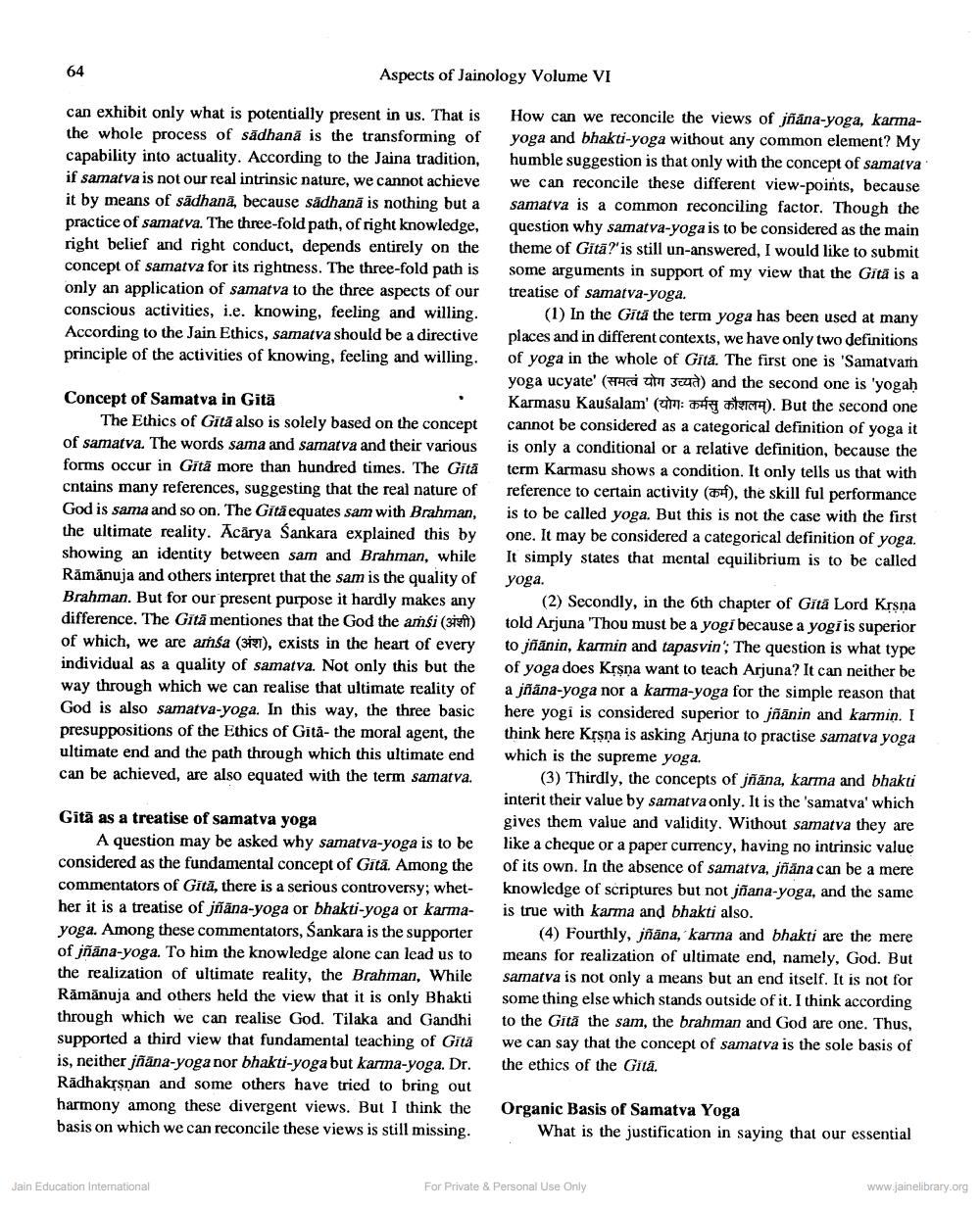Book Title: Samatva Yoga Fundamental Teaching Of Jainism And Gita Author(s): Sagarmal Jain Publisher: Z_Jaina_Literature_and_Philosophy_a_Critical_Approach_001936_HR.pdf View full book textPage 2
________________ 64 Aspects of Jainology Volume VI can exhibit only what is potentially present in us. That is How can we reconcile the views of jñana-yoga, karmathe whole process of sādhanā is the transforming of yoga and bhakti-yoga without any common element? My capability into actuality. According to the Jaina tradition, humble suggestion is that only with the concept of samatva if samatva is not our real intrinsic nature, we cannot achieve we can reconcile these different view points, because it by means of sadhana, because sädhanā is nothing but a samatva is a common reconciling factor. Though the practice of samatva. The three-fold path, of right knowledge, question why samatva-yoga is to be considered as the main right belief and right conduct, depends entirely on the theme of Gita?' is still un-answered, I would like to submit concept of samatva for its rightness. The three-fold path is some arguments in support of my view that the Gită is a only an application of samatva to the three aspects of our treatise of samatva-yoga. conscious activities, i.e. knowing, feeling and willing. (1) In the Gitä the term yoga has been used at many According to the Jain Ethics, samatva should be a directive places and in different contexts, we have only two definitions principle of the activities of knowing, feeling and willing of yoga in the whole of Gita. The first one is 'Samatvar yoga ucyate' (Tucut goud) and the second one is 'yogah Concept of Samatva in Gitā Karmasu Kausalam' (योगः कर्मसु कौशलम्). But the second one The Ethics of Gită also is solely based on the concept cannot be considered as a categorical definition of yoga it of samatva. The words sama and samatva and their various is only a conditional or a relative definition, because the forms occur in Gitā more than hundred times. The Gită term Karmasu shows a condition. It only tells us that with cntains many references, suggesting that the real nature of reference to certain activity (+), the skill ful performance God is sama and so on. The Gitä equates sam with Brahman, is to be called yoga. But this is not the case with the first the ultimate reality. Acarya Sankara explained this by one. It may be considered a categorical definition of yoga. showing an identity between sam and Brahman, while It simply states that mental equilibrium is to be called Ramanuja and others interpret that the sam is the quality of yoga. Brahman. But for our present purpose it hardly makes any (2) Secondly, in the 6th chapter of Gītā Lord Krsna difference. The Gitä mentiones that the God the amsi (3ies) told Arjuna "Thou must be a yogi because a yogi is superior of which, we are amsa (321), exists in the heart of every to jñanin, karmin and tapasvin', The question is what type individual as a quality of samatva. Not only this but the of yoga does Krsna want to teach Arjuna? It can neither be way through which we can realise that ultimate reality of a jñāna-yoga nor a karma-yoga for the simple reason that God is also samatva-yoga. In this way, the three basic here yogi is considered superior to jñanin and karmin. I presuppositions of the Ethics of Gita- the moral agent, the think here Krsna is asking Arjuna to practise samatva yoga ultimate end and the path through which this ultimate end which is the supreme yoga. can be achieved, are also equated with the term samatva. (3) Thirdly, the concepts of jñana, karma and bhakti interit their value by samatva only. It is the 'samatva' which Gitä as a treatise of samatva yoga gives them value and validity. Without samat va they are A question may be asked why samatva-yoga is to be like a cheque or a paper currency, having no intrinsic value considered as the fundamental concept of Gită. Among the of its own. In the absence of samatva, jñana can be a mere commentators of Gitā, there is a serious controversy, whet- knowledge of scriptures but not jñana-yoga, and the same her it is a treatise of jñāna-yoga or bhakti-yoga or karma is true with karma and bhakti also. yoga. Among these commentators, Sankara is the supporter (4) Fourthly, jñāna, karma and bhakti are the mere of jñāna-yoga. To him the knowledge alone can lead us to means for realization of ultimate end, namely, God. But the realization of ultimate reality, the Brahman, While samatva is not only a means but an end itself. It is not for Rāmānuja and others held the view that it is only Bhakti some thing else which stands outside of it. I think according through which we can realise God. Tilaka and Gandhi to the Gită the sam, the brahman and God are one. Thus, supported a third view that fundamental teaching of Gităw e can say that the concept of samatva is the sole basis of is, neither jñana-yoga nor bhakti-yogabut karma-yoga. Dr. the ethics of the Gita. Rādhakrsnan and some others have tried to bring out harmony among these divergent views. But I think the Organic Basis of Samatva Yoga basis on which we can reconcile these views is still missing. What is the justification in saying that our essential Jain Education International For Private & Personal Use Only www.jainelibrary.orgPage Navigation
1 2 3
